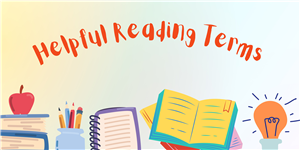-

-
alphabetic knowledge -Knowing the names and shapes of the letters of the alphabet
-
alphabetic principle- The understanding that written letters represent sounds. For example, the word big has three sounds and three letters.
-
segmenting-the ability to separate the sounds in a spoken word (h-o-p)
-
blending- Pronouncing individual sounds in a word without stopping, blending the sounds into a spoken word
-
comprehension-The ability to understand and gain meaning from what has been read
-
decodable books- Books that are predominantly made up of words that contain only the letter-sound relationships that the children are learning
-
decode- The ability to recognize and read words by translating the letters into speech sounds to determine the word's pronunciation and meaningencode-the ability to spell words using correct letters for the speech sounds in a word
-
invented spelling-often referred to as 'kid spelling'; your child's attempt to spell a word the way it sounds. Invented spelling attempts allow teachers to monitor your child's spelling development and guides instruction.
-
emergent literacy-The view that literacy learning begins at birth and is encouraged through participation with adults in meaningful reading and writing activities
-
environmental print- Print that is part of everyday life, such as signs, billboards, labels, and business logos
-
explicit instruction- Direct, structured, systematic teaching
-
fluency- The ability to read text accurately and quickly with expression that conveys comprehension
-
graphic organizers- Diagrams that visually represent the organization and relationships of ideas in a text
-
informational text- Text that conveys information - this may include books, magazines, websites, directions, etc.
-
memory words- story words that use any letter-sound relationships that your child has not learned yet. These include words which have irregular phonic elements, often referred to as 'sight words'.Pattern words-words that have a consistent phonic element that your child is learning how to read and spell.
-
leveled books- Books that have been assigned a particular level (usually a number or letter, such as Level 1 or Level B) intended to indicate how difficult the book is for children to read
-
literacy-Includes all the activities involved in speaking, listening, reading, writing, and appreciating both spoken and written languageFor more reading terms go to http://www.readingrockets.org/teaching/glossary/
-
Last Modified on November 28, 2022

